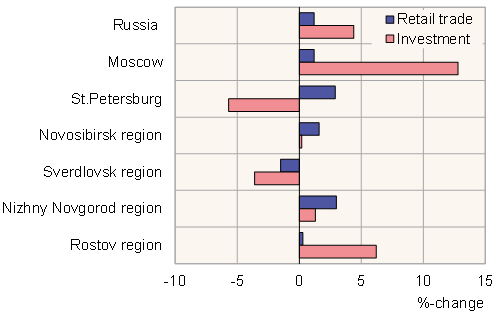BOFIT Weekly Review 11/2018
Uneven development in Russian regions last year
While Russian industrial output and retail sales overall grew by about 1 % last year, industrial output growth across federal districts (FD) ranged between 1–3 %. Retail sales increased in nearly all federal districts by 1–2 %, even if real incomes continued to fall in all federal districts except the Northern Caucasus. Industrial output and retail sales in Moscow increased near the average pace, while growth in St. Petersburg was somewhat higher.
Variations in fixed investment and construction were greater. Nationally, fixed investment increased by 4 %, while construction activity decreased by just over 1 %. Supported by e.g. the Power of Siberia pipeline project, fixed investment in the Far East FD soared by 17 % and construction by 9 %. Growth was also strong in the illegally annexed Crimea, due largely to the construction of the federal budget funded Kerch Bridge. About 13 % of all federal budget fixed investment last year went to Crimea and Sevastopol, whereas only about 9 % of investment went to the North Caucasian FD, 6 % to the Far East FD and 4 % to Arctic regions. In contrast to other federal districts, fixed investment contracted by 4 % in the Volga FD and construction fell by 12 % in the Northwestern FD on weak trends in St. Petersburg and the Komi Republic. In other regions of the Northwestern FD, however, fixed investment and construction grew rapidly. Regional variation within all federal districts was again large.
The economic recession of recent years has overall been reflected unevenly in the economic performances of Russia's regions. While Russian GDP overall contracted by about 3 % in 2015–2016, GDP growth across Russia's over 80 regions ranged from a contraction of 12 % to growth above 20 %. While there seems to be no clear geographical patterns, growth regions included e.g. northern oil and gas producer regions (Nenets and Yamalo-Nenets autonomous okrugs), the Republic of Chechnya (which relies heavily on federal budget funding) and the Tula region (which has benefitted e.g. from heavy defence spending in recent years).
Income levels also vary widely across regions. In terms of purchasing power, Russia's richest regions include Moscow and St. Petersburg, while the poorest regions are found in ethnic minority-dominated republics in southern and south-eastern Russia such as Ingushetia, Tuva and Kalmykia.
2017 retail trade and investment growth in selected regions, %

Source: Rosstat.